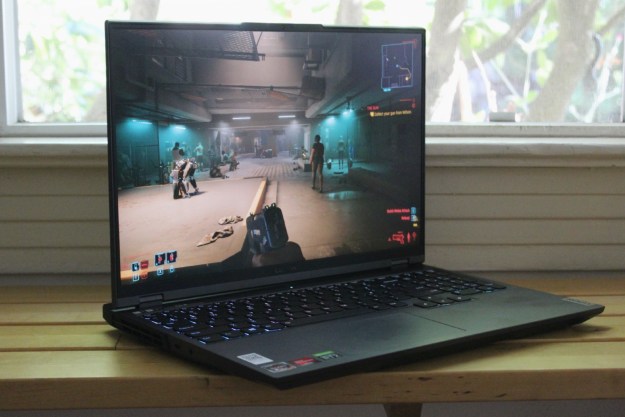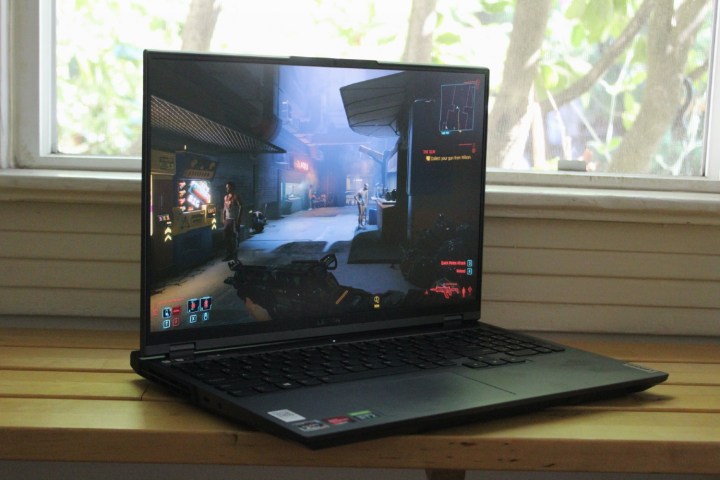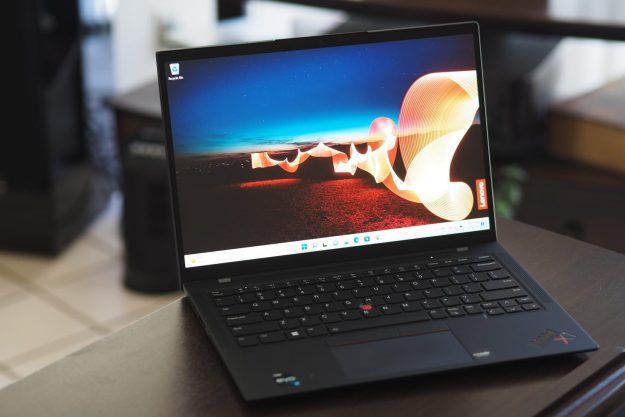
“The display quality and performance make the Lenovo Legion 5 Pro a fantastic midrange gaming laptop.”
- Excellent gaming performance
- Gorgeous 1440p display
- Satisfying, accurate keyboard
- Good cooling
- Cheap touchpad
- Thick and chunky
Gaming laptops keep getting thinner. Yet, there’s plenty of room in the market for gaming laptops that don’t sacrifice unbridled performance at the altar of portability.
The Lenovo Legion 5 Pro is one such gaming laptop. Its design is nothing spectacular, nor is the strain you’ll feel when lugging this thing around.
But for a decidedly old-school gaming laptop, the Legion 5 Pro gets the fundamentals right in a way that will make many performance-focused PC gamers very happy. The affordable starting price of $1,700 starting price will put a smile on your face too.
Design

The Legion 5 Pro ain’t a looker. The oversized Legion logo on the lid isn’t exactly subtle, and the sleepy storm gray color and keycap font are straight out of Lenovo’s business laptop designs. Throw in the ThinkPad-like keyboard and the black vent pieces that seem glued on, and it’s a bit of a Frankenstein design.
I don’t have a problem with a stealthy gaming laptop that hides its gaming roots — like the Predator Triton 500 SE, or even the Razer Blade 15. But the Legion 5 Pro seems torn between both identities. Even its name seems a bit confusing, as it’s both in the Legion gaming line but also a “Pro” laptop. It’s less a blend and more a mishmash.
The design does have its strengths. The superthin bezels around the screen, for example, look amazing. Even the bottom bezel is relatively small, making for a modern design that puts the screen at the forefront. For that, you can thank the 16:10 aspect ratio, which is a new trend in gaming
The screen is also larger than your average 15-inch gaming laptop, measuring at 16 inches diagonally. That matches the Predator Triton 500 SE, but it’s still an uncommon screen size for gaming
And that’s important, because the Legion 5 Pro is not small by any standard. It weighs 5.4 pounds and is 1.1 inches thick — chunkier than your average 15-inch laptop and most of the higher-end gaming
Ports

The Legion 5 Pro features an increasingly popular option for port placement: The rear side of the device. This makes the laptop’s footprint even larger, but it does a good job of keeping messy cables out of your way.
In back, you’ll find
That leaves only ports you’ll really need quick access to on the sides. On the left, you’ll find a headphone jack and another USB-C. There’s a single USB-A port on the right side.
As for connectivity, the Legion 5 Pro supports Wi-Fi 6 and Bluetooth 5.1.
Display

The Legion 5 Pro includes an excellent screen, both for gaming and for standard work. It’s native resolution is 2560 x 1600 to support the 16:10 aspect ratio, and can be downscaled to 1920 x 1200 for lower-resolution gaming.
According to my colorimeter, the Legion 5 Pro has one of the best displays I’ve ever tested on a gaming laptop. First off, it’s inordinately bright, maxing out at 550 nits of brightness. That’s even brighter than the most recent MacBook Pro or Razer Blade 15. It’s also a decently color-accurate panel, hitting 77% of the AdobeRGB color space.
The Legion 5 Pro has one of the best displays I’ve ever tested on a gaming laptop.
It’s rare to see a screen this bright, vibrant, and well-calibrated on a gaming laptop. Again, like the Predator Triton 500 SE, the Legion 5 Pro features that great image quality alongside a quick refresh rate, though 165Hz isn’t as high as the 360Hz panels you can get in 1080p gaming
The boost in resolution is worth the trade-off, especially on a screen this large. Pixels disappear thanks to how sharp it is, which matches what you get on the MacBook Pro. And thanks to the performance, you’ll find yourself using the full range of 165Hz even at native resolution.
Performance
As I’ve mentioned, the Legion 5 Pro is a chunky gaming laptop, and that affords it some better cooling. The result is pretty astounding gaming performance.
My configuration came with the AMD Ryzen 7 5800H, Nvidia RTX 3070, 16GB of RAM, and two 1TB PCIe SSDs. Lenovo also offers an identical configuration, except with the RTX 3060. You’ll save $150 there, but the RTX 3070 option should offer a noticeable increase in frame rates. It’s not currently available, but Lenovo also reportedly offers a confusing midtier model with just 1TB of storage but 32GB of
| Laptop | 3DMark Time Spy | 3DMark Fire Strike | Assassin’s Creed Valhalla (1080p Ultra High) | Battlefield V (1080p Ultra) | Fortnite (1080p Epic) | Civilization VI (1080p Ultra) |
| Lenovo Legion 5 Pro (RTX 3070) | 9175 | 21033 | 61 fps | 73 fps | 101 fps | 114 fps |
| Asus ROG Strix G15 (RX 6800M) | 10504 | 26800 | 77 fps | 109 fps | 108 fps | 150 fps |
| MSI GS66 Stealth (RTX 3080) | 9097 | 19175 | 70 fps | 117 fps | 140 fps | 149 fps |
| Razer Blade 15 (RTX 2080 Super) | 7637 | 16895 | 58 fps | 98 fps | 110 fps | 134 fps |
I included the benchmarks in 1080p in the chart above to level the playing field between these different
At native resolution, which is how many people will likely use the Legion 5 Pro, you’ll still get 60-plus fps in most games. Battlefield V was right on the line at 60 fps, while Fortnite played fantastically at 83 fps. The system slowed down to 52 fps at 2560 x 1600 in Valhalla, so you’ll likely want to stick to lower resolutions for heavier titles like that.
The Legion 5 Pro is a great value for the performance offered.
Though the Legion 5 Pro with RTX 3070 consistently beat the MSI GS66 Stealth with RTX 3080 (and 1440p screen) in 3DMark runs, the MSI machine was decidedly ahead in every actual game I tested. Of course, newer configurations of the GS66 Stealth aren’t widely available right now — and if they are, they’ll be quite a bit more expensive. The same is true of the Razer Blade 15, which will easily cost you at least $1,000 more.
All of that sets up the Legion 5 Pro to be a great value for the performance offered. The one problem is the Asus ROG Strix G15, which offers a base configuration at a similar $1,650. It’s a more powerful laptop, no doubt about it. It’s a strength of AMD’s new Radeon RX 6800M graphics card, which beats the RTX 3070 in every case and challenges the RTX 3080 in some. The performance of the ROG Strix G15 is undeniable. I prefer the design and screen of the Lenovo Legion 5 Pro, but it’s hard to beat the ROG Strix G15 purely on value.

Throughout my testing, the Legion 5 Pro proved to be a well-cooled device. GPU temperatures never rose over 86 degrees Celsius, while CPU temperatures were even cooler. Surface temperatures did get warm at times, but never quite as hot as slimmer
All configurations of the Legion 5 Pro feature the AMD Ryzen 7 5800H. It’s a powerful, 45-watt chip with eight cores and 16 threads. That gives you improved CPU performance over the 35-watt processors found in something like the ROG Zephyrus G14. The Legion 5 Pro had a particularly impressive single-core score of 1430 in Cinebench R23. It scores quite a bit higher than Intel-powered
I also tested CPU-based video encoding in HandBrake, and the Ryzen 7 was an absolute speedster. The GS66 Stealth, by comparison, was 24% slower in the same test. That ensures that the Legion 5 Pro is as good a machine for content creation and heavier CPU-based workloads as it is in gaming.
Still, it’s not quite as fast as the Ryzen 9 5900HX that you’ll find in the ROG Strix G15 or ROG Zephyrus G15.
Battery
The Lenovo Legion 5 Pro doesn’t get great battery life. Other gaming
Still, battery life isn’t nearly as bad as a laptop like this would have been in years past, which is likely thanks to the efficient Ryzen processor inside. Just over seven hours in light web browsing isn’t awful. The second you boot up the discrete GPU, though, you’ll see that drop pretty fast. Then again, you probably shouldn’t be gaming without being plugged in anyway.
I should also mention the massive 300-watt power brick that ships with this thing. It’s a tank, and adds some heft in the backpack if you plan on traveling with the Legion 5 Pro.
Keyboard and touchpad

The Legion 5 Pro uses a precise, ThinkPad-esque keyboard. It’s an odd look for the keycaps on a gaming laptop, but it makes for one of the best typing experiences you’ll find. The 1.5mm of key travel is luxurious, and the layout is perfect. The backlighting is fairly limited, with just four zones of customization (including the numpad) and an underwhelming software experience using Lenovo Vantage. The joy of the typing experience more than makes up for the lack of fancy backlighting.
That made the quality of the touchpad even more of a disappointment. It’s the kind of quality you’d find on a $400 Chromebook, not a powerful gaming laptop. It’s a large touchpad, which I appreciate. But the surface isn’t very smooth, meaning click-and-drag, pinch-to-zoom, or other gestures that require precise tracking can skip or feel clumsy. It’s frustrating, especially on a laptop that gets so many things right.
Above the screen, you’ll find a 720p webcam, which I’m happy Lenovo included. It’s still being left out of Asus’ ROG gaming
Our take
The Lenovo Legion 5 Pro is the real deal. If you’re done with gaming
Are there any alternatives?
Most gaming
The two biggest competitors to the Legion 5 Pro are from Asus. The all-AMD ROG Strix G15 is the ultimate value gaming laptop, while the ROG Zephyrus G15 matches the Legion 5 Pro in nearly ever spec for the same price. It doesn’t have as good of screen, but the Zephyrus G15 has a sleeker design and options for up to an RTX 3080.
How long will it last?
The Lenovo Legion 5 Pro should last you at least five years. It’s a capable gaming laptop that should be able to handle the latest AAA games for many years.
Should you buy it?
Yes. The Lenovo Legion 5 Pro isn’t the sleekest gaming laptop in the world, but its performance and display more than make up for the difference.
Editors' Recommendations
- Windows 10 Home vs. Pro vs. S mode: What’s the difference?
- Apple could soon put an M3 chip in its worst laptop
- Samsung’s first flat mini-LED gaming monitor doesn’t come cheap
- The best gaming PCs for 2023: Dell, Origin, Lenovo, and more
- USB-C charging laptops: Here’s what you need to know








